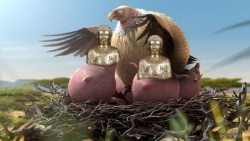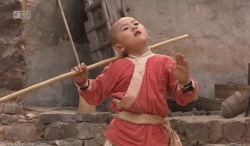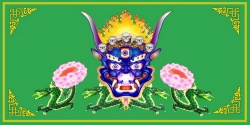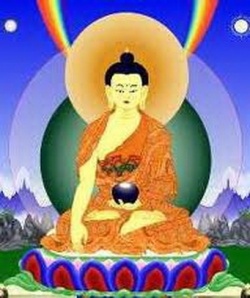The Jeweled Net of Indra
Delivered to the First Unitarian Church of Wilmington Delaware April 17, 2011
By Rev. Dr. Joshua Snyder
The Jeweled Net of Indra is a metaphor for the Buddhist understanding of interdependence. What Unitarian Universalists like to call the interdependent web, Buddhists use the metaphor of a net that spreads out into infinite space, filled with jewels in which each jewel reflect all of the others. Each jewel is a person, a being, even a moment in time. The point being that no person is an island, as John Dunne observed. Each moment, every living and nonliving thing is contained in every other. My existence depends on the food I eat and the air I breathe, not to mention the people I love and the impact of friends and family that have shaped my life. All of these factors that have lead up to this very moment are infinite. It is impossible to count all the little things that may have been different, but have gone into allowing this moment to happen. Right now, all of us, are reflecting all of those factors with every breath we take and every word we speak. Our lives are living miracles.
Jeweled Net of Indra: Associated with the Avatamsaka Sutra, with its conception of unity and universal interdependence this is one of the most beautiful and profound metaphors in the mahayana tradition. There is a net in the abode of the great god Indra, which has been hung by some cunning artificer in such a manner that it stretches out infinitely in all directions. In accordance with the extravagant tastes of deities, the artificer has hung a single glittering jewel in each "eye" of the net, and since the net itself is infinite in dimension, the jewels are infinite in number. In looking at each jewel, you discover that in its polished surface there are reflected all the other jewels in the net, infinite in number. The Hua-Yen Avatamsaka school mentioned this image many times in its literature, because it symbolizes a cosmos in which there is an infinitely repeated interrelationship among all the members of the cosmos. This relationship is said to be one of simultaneous mutual identity and mutual inter causality.
This vision of an interconnected ever-changing world is at the center of Buddhist theology. Buddhists do not have a Western notion of God or heaven. What they have is a sense that we are all interconnected and interdependent on each other and especially on the Earth. When we have the wisdom of Manjushree we understand this interconnection of ourselves and the planet. As a result of this insight we develop the compassion of Maitreya who feels deeply in his bones the suffering of all people and animals and the brokenness of our planet. We are then moved to action and to everyday practice; just as Samanthabhadra charged Sudhana to do for the rest of his life. Wisdom and compassion lead to practice and social action.
We have all been shocked and astounded by the suffering in Japan in the last month. An earthquake rocked the country. But it was not simply one earthquake. There were earthquakes all around the Pacific Rim in New Zealand, California, Chile, and even a big aftershock in Japan. When the Earth’s plates shift in one place, it causes shifts in all the others. If you put a scratch in one of the jewels in Indra’s net you will see that scratch in every other one.
Of course we see this in time as well as in space. The earthquake caused a tsunami which devastated the eastern side of the country. The tsunami destroyed the containment on the Fukushima nuclear power plant causing a meltdown or something very close to a meltdown. We saw this a few years ago when Hurricane Katrina, devastating in its own right, broke the levies in New Orleans and flooded the entire city. One disaster leads to another. As Martin Luther King observed in a different but not dissimilar context, the fate of others is tied to our own. When I think of this reality, it can be a very gloomy perspective.
It is as if Indra’s Jeweled Net has made me directly responsible for everything in the universe. As a single individual I am not in control of everything that happens, and certainly not earthquakes and tsunamis. And yet the Jeweled Net can bring a hopeful message too. A single individual, a single jewel in the net, can effect change in all the others. Lots of jewels working together in concert for the same goal can effect even more change. Hope is real thing, and the jeweled net teaches us that even the minutest action toward the good that we may take makes significant change throughout the world.
Although he said it in a different way, this was the point of Governor Russ Peterson’s www.motherearthnews.com “Declaration of Interdependence www.delenvirosummit.org.” It is both an acknowledgement of our place in the jeweled net of Indra and a vow to work toward healing the planet. For he understood, and urges us to understand, that the fate of the planet and our own fate cannot be separated. Granted in our daily life it is easy to get wrapped up in our own dramas and forget this truth. Sometimes when a piece of the truth is so obvious we forget to look at it.
Earth Day is a day set aside to remember these obvious facts of our life. Of course the health and sustainability of the Earth is tied inextricably to our own life and well-being.
So today, as we celebrate
Earth Day, part of what we need to do is to simply remember and be aware of our interdependence. But Russ Peterson www.motherearthnews.com, a kind of modern day manifestation of Samanthabhadra, would not let us merely contemplate our interconnections in worship this morning. He would urge us to go out and get dirty. He would tell us that the real work of our religion, a sign that we have reached the pinnacle of our own spiritual journey, is how we take that understanding into our lives. Can we remember our interconnectedness on the days that are NOT Earth Day? Can we have that sense of urgency, that Sudhana has at the end of the story, that we need to go out and help those who are suffering? Can we experience their suffering with our own and not lose sight of our individuality? These are the spiritual challenges presented to us on Earth Day. May our lives be the answers to these questions. And may we never tire of working for a planet transformed by our care.



